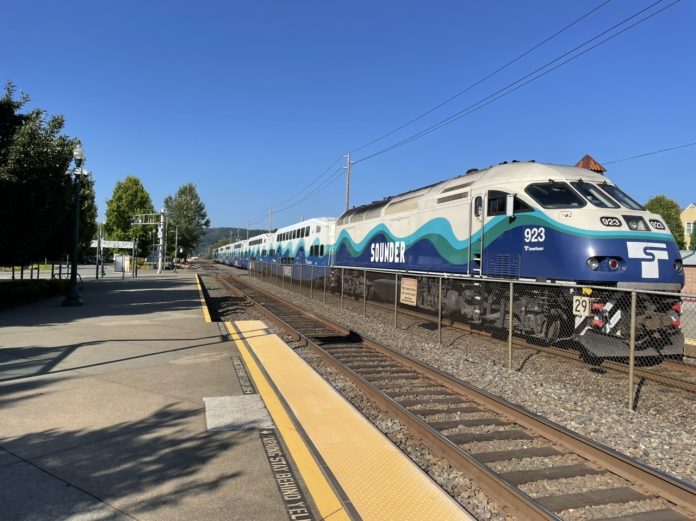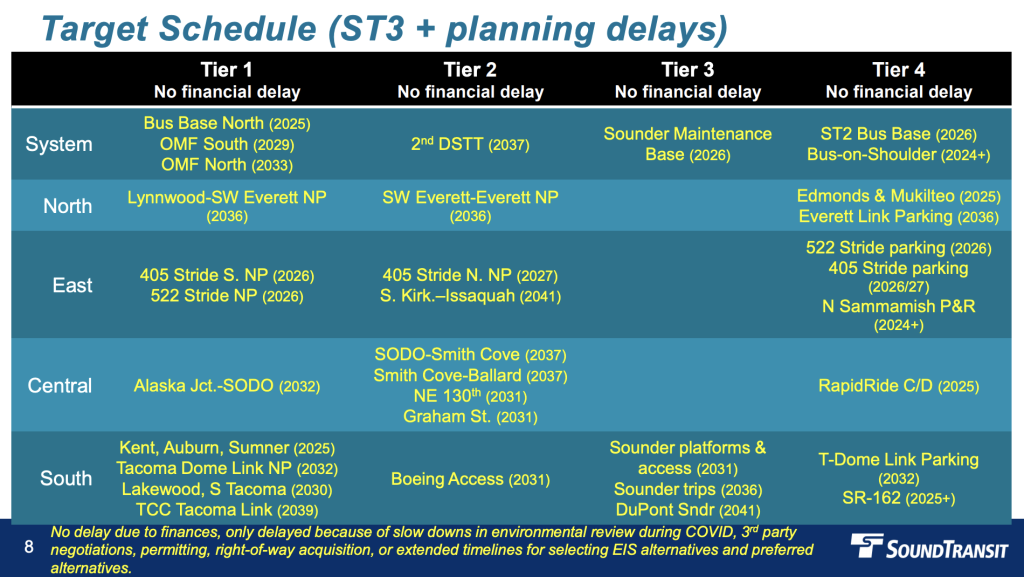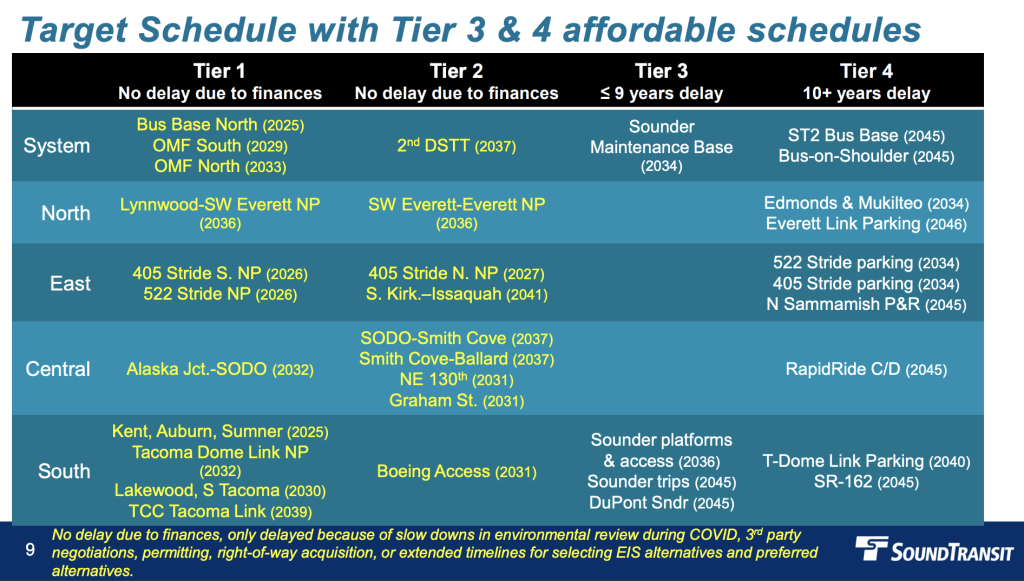Update (8/2/2021): This article was updated to include additional amendments that were published on August 2, 2021.
A final vote on realignment of the Sound Transit 3 program could come this Thursday to solve a $6.5 billion affordability gap. The Sound Transit Board of Directors will meet to review and consider two plans: the original base realignment with immediate delays and a hybrid realignment plan, which would allow the program to move forward for now mostly on schedule or close to it. Board Chair Kent Keel threw his support behind the hybrid realignment plan last week saying that he and King County Councilmember Claudia Balducci had worked out the compromise plan.
“I believe this hybrid combines the best of my approach and the best of [Balducci’s] approach that she’s been working,” Keel said.
Assuming that the hybrid realignment plan is supported by the board, many projects could sail ahead on-time if offsets (e.g., additional revenue/financial capacity and cost savings) can be found to meet the target schedule. Some projects may still be affected by “planning delays,” which means they could be delayed by several years. However, Balducci has said there is an expectation that the agency will try to recover that time as much as possible.
The hybrid realignment plan will be a delicate balancing act. It’s been described as a “tightrope with a safety net” since it’s built around two very different sets of schedules: the target schedule (tightrope) and the affordable schedule (safety net). Securing new and additional revenue, working to attain cost savings, and controlling project costs won’t be an easy task.
In keeping with Chair Keel’s original plan, the draft hybrid realignment plan resolution would retain the prioritized tiered approach to projects. To reduce the risk of key project delays, Tier 1 and Tier 2 projects would remain the priority while Tier 3 and Tier 4 projects are functionally placed in a delayed status for now; those delayed projects tend to be parking projects though the Sounder commuter rail expansion projects and RapidRide C and D Lines Improvement project are among them, too. Nevertheless, it will remain an objective to deliver Tier 3 and Tier 4 projects on-time as well, but only once the board has been assured that Tier 1 and Tier 2 projects can delivered as planned.
Funding gaps requiring offsets differ greatly by project and mainly hit Tier 2 projects in the hybrid realignment plan. According to the agency, these funding gaps stand at:
- $21 million for Tacoma Community College Tacoma Link;
- $602 million for Southwest Everett-Everett Link;
- $1.824 billion for Smith Cove-Ballard Link;
- $65 million for the NE 130th Street Link infill station;
- $8 million for the Graham Street Link infill station; and
- $25 million for the Boeing Access Road Link infill station.
At the behest of Chair Keel, boardmembers were directed to bring forward reworked amendments if they had budgetary impacts with identified offsets. Thus, some amendments that had been proposed in recent weeks have fallen away or been amended. As of Monday, August 2nd, the following key amendments are proposed:
- Cost savings: Seattle Mayor Jenny Durkan wants a requirement that reviews operations, maintenance, administrative, and personnel costs for cost savings. This could further help with the many different endeavors to save money that have been identified in the realignment resolutions.
- Interim station access: Kenmore Mayor David Baker wants to include an annual program review item that looks at ways to get riders to stations if structured parking facilities are delayed. This could mean things like interim connector bus service or microtransit options.
- Three Link infill stations (Keel): Chair Keel wants to adjust the timing of all three Seattle infill stations (NE 130th Street, Graham Street, and Boeing Access Road) and the Smith Cove-Ballard Link extension. The amendment affects the affordable schedule by moving all three infill stations from Tier 2 to Tier 1 with earlier delivery dates. NE 130th Street would move up from 2036 to 2025 while Graham Street and Boeing Access Road would move up from 2036 to 2031. However, Smith Cove-Ballard Link would move back from 2039 to 2040. Additionally, the amendment would affect the target schedule by moving all three infill stations from Tier 2 to Tier 1 and move up the delivery date for NE 130th Street from 2036 to 2025. These changes are assumed to have no net financial impact.
- One Link infill station (Durkan): Mayor Durkan has a more narrow Link infill station amendment. Hers would only move up the Graham Street infill station in the affordable schedule from Tier 2 to Tier 1 and the delivery date from 2036 to 2031. It would also adjust the target schedule by moving up Graham Street from Tier 2 to Tier 1. This change, however, would have financial impacts and require additional offsets to achieve.
- Parking and Sounder delays: Pierce County Executive Dammeier, Fife Mayor Kim Roscoe, and Tacoma Mayor Victoria Woodards want to delay additional Sounder trips to advance parking projects. Part of the surprising justification for this amendment is to satisfy a narrow segment of riders and advance sprawl, rather than connect riders in a more efficient and sustainable manner like station-oriented bus service. The amendment would delay more South Sounder trips until 2046 while Tacoma Dome Link parking projects would be moved up two years to 2038 and moved from Tier 4 to Tier 3. This, however, is entirely inconsistent with the transit priority and parking delay principles of the realignment framework and an intentional act of climate arson.
- I-405 BRT North: Councilmember Balducci is proposing several changes to the I-405 Stride North No Parking (NP) and I-405 Stride Parking projects. Her amendment would bifurcate the I-405 Stride North NP project by moving the I-405/NE 85th Street Interchange and Inline BRT Station portion from Tier 2 to Tier 1 in the affordable schedule with a completion date of 2026 instead of 2027. It would also adjust the I-405 Stride Parking (Tier 4) project by moving the Kingsgate parking element back from 2034 to 2035. The amendment would make the exact same set of changes to target schedule.
- Two Link infill stations (Juarez): Seattle City Councilmember Debora Juarez is proposing two different infill station amendments that would be paid for by partially delaying the SR-522/145th Stride Parking project. Her first amendment would move up the NE 130th Street and Graham Street infill station from Tier 2 to Tier 1 in both the affordable and target schedules; this would also push the completion dates forward from 2036 with delivery of NE 130th Street in 2025 and Graham Street in 2031. To pay for the change, the Lake Forest Park portion of the SR-522/145th Stride Parking (Tier 4) project would be pushed back from 2034 to 2044.
- One Link infill station (Juarez): Juarez’s second amendment is a more narrow alternative that would adjust the NE 130th Street infill station in both the affordable and target schedules by moving it from Tier 2 to Tier 1 and pushing the completion date forward from 2036 to 2025. Additionally, the Lake Forest Park portion of the SR-522/145th Stride Parking (Tier 4) project would be pushed back from 2034 to 2038.
The meeting on Thursday will no doubt be a rollercoaster as boardmembers decide which realignment path to take and make the case for their amendments. Whether it will end up in a good or bad place remains to be seen.
You can weigh in on the realignment plan and amendments ahead of the meeting by emailing the board at emailtheboard@soundtransit.org. Comments will be accepted up until the meeting on Thursday, August 5th at 1:00pm. Verbal comments can also be provided at the virtual online meeting by signing up beforehand.
Stephen is a professional urban planner in Puget Sound with a passion for sustainable, livable, and diverse cities. He is especially interested in how policies, regulations, and programs can promote positive outcomes for communities. With stints in great cities like Bellingham and Cork, Stephen currently lives in Seattle. He primarily covers land use and transportation issues and has been with The Urbanist since 2014.




